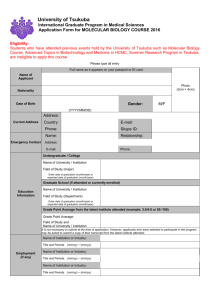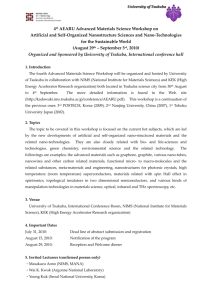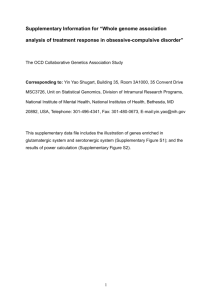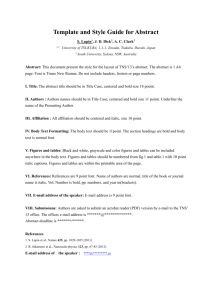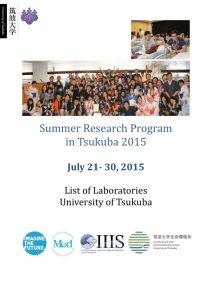Double somatic mosaic mutations in TET2 and DNMT3A – origin of
advertisement
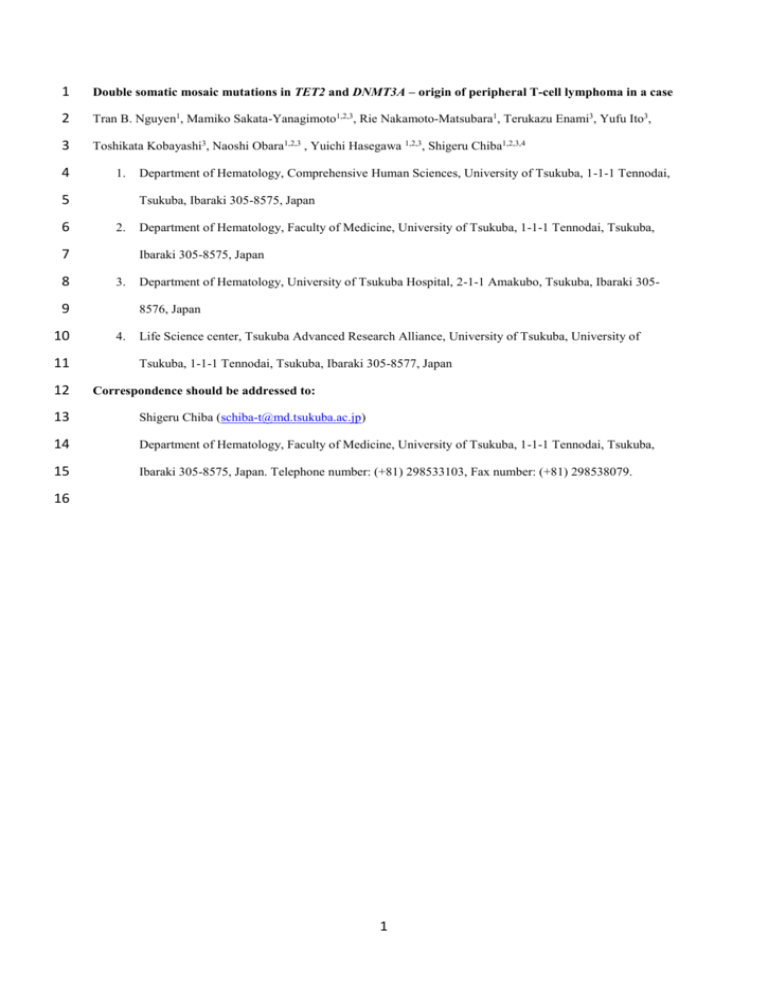
1 Double somatic mosaic mutations in TET2 and DNMT3A – origin of peripheral T-cell lymphoma in a case 2 Tran B. Nguyen1, Mamiko Sakata-Yanagimoto1,2,3, Rie Nakamoto-Matsubara1, Terukazu Enami3, Yufu Ito3, 3 Toshikata Kobayashi3, Naoshi Obara1,2,3 , Yuichi Hasegawa 1,2,3, Shigeru Chiba1,2,3,4 4 1. 5 6 Tsukuba, Ibaraki 305-8575, Japan 2. 7 8 11 12 Department of Hematology, Faculty of Medicine, University of Tsukuba, 1-1-1 Tennodai, Tsukuba, Ibaraki 305-8575, Japan 3. 9 10 Department of Hematology, Comprehensive Human Sciences, University of Tsukuba, 1-1-1 Tennodai, Department of Hematology, University of Tsukuba Hospital, 2-1-1 Amakubo, Tsukuba, Ibaraki 3058576, Japan 4. Life Science center, Tsukuba Advanced Research Alliance, University of Tsukuba, University of Tsukuba, 1-1-1 Tennodai, Tsukuba, Ibaraki 305-8577, Japan Correspondence should be addressed to: 13 Shigeru Chiba (schiba-t@md.tsukuba.ac.jp) 14 Department of Hematology, Faculty of Medicine, University of Tsukuba, 1-1-1 Tennodai, Tsukuba, 15 Ibaraki 305-8575, Japan. Telephone number: (+81) 298533103, Fax number: (+81) 298538079. 16 1 1 Supplementary methods 2 Patient and samples. 3 Samples were obtained with written informed consent after approval by the ethics committee in the University 4 of Tsukuba Hospital. Genomic DNA was extracted from paraffin-embedded formalin-fixed (FFPE) samples of 5 lymph node, bone marrow mononuclear cells (MCs), buccal mucosal cells, and nails. Mutations in TET2 and 6 DNMT3A in the tumor sample of this patient were shown in the previous reports: TET2 c.A3443G:p.Y1148C 7 and DNMT3A c.T2264C:p.F755S [1]. 8 Sorting of tumor cell-enriched fraction and other fractions. 9 MNCs were isolated from peripheral blood (PB) of the patient by Ficoll-Paque density gradient centrifugation. 10 MNCs were stained by fluorescein isothiocyanate (FITC)-conjugated anti-CD4, anti-CD14 antibody (BD 11 Biosciences, Cat. 555397), and phycoerythrin (PE)-conjugated anti-CD8, anti-CD19 antibody (Dako, clone 12 HD37), and allphycocyanin (APC)-conjugated anti-CD279/PD1 antibody (Bio legend, clone EH12.2H7), and 13 then fractionated by FACS Aria (BD Biosciences). 14 Cell lysate was obtained by adding lysis buffer (0.3% Tween 20, 0.3% NP-40, 10mg/ml proteinase K and pH 15 8.0 Tris- EDTA buffer). The lysate was incubated at 55oC for 1 hour and then at 80oC for 10 minutes. One µL of 16 cell lysate which contained approximately 100 cells was used for polymerase chain reaction (PCR) under the 17 following conditions: 94oC for 2 minutes, 35 cycles of 98oC for 10 seconds and 68oC for 30 seconds by KOD - 18 Plus- Neo kit (TOYOBO) with each primer set (supplementary Table 4). PCR amplicons were used for 19 amplicon-based sequencing and Sanger sequencing. 20 Amplicon-based sequencing to determine the allele frequencies of the mutations in various cells and 21 tissues by Ion Torrent PGM. 22 The libraries were made by using the Ion Plus Fragment Library kit according to the protocol for preparing short 23 amplicon libraries (Life technologies). Briefly, PCR amplicons were ligated to barcode adapters and P1 24 adapters, and then amplified. Quantitation of the amplified libraries was performed by quantitative PCR with the 25 Ion Library Quantitation kit according to manufacturer’s instruction (Life technologies). The libraries were then 26 subjected to deep sequencing on Ion Torrent PGM according to the standard protocol for 300 base pair single- 27 end reads (Life technologies). The data was analyzed by Variant caller 3.4 (Life technologies). The single 28 nucleotide variant at nucleotide position A to G at c.A3443 of TET2 and that from T to C at c.T2264 of 29 DNMT3A comprising equal to or more than 0.5% were adopted as the mutations (supplementary Table 2). 30 Colony forming analysis from PB MCs. 2 1 PB MCs were cultured in MethoCult H4435 Enriched (STEMCELL Technologies) for 15 days. Each colony 2 was harvested. Genomic DNA of the colonies was directly amplified using Repli G single cell kit (QIAGEN). 3 The DNA solution was diluted 100 times and 2ul of these were used for Sanger sequencing. 4 3 1 2 Supplementary Figure 1: Protein structure of TET2 and DNMT3A [2] 3 Cys-rich: Cystein-rich domain; Core-DSBH: Core double-strain-beta-helix domain; PWWP: PWWP domain; 4 ADD: ADD domain; SALMDM: S-adenosyl-L-methionine-dependent-methyltransferase domain 5 4 1 Supplementary Table 1. Mutation profile Annotated Mutation Nucleotide Amino acid genes Type Change Transcript CACNA1D NM_000720 Missense c.C992T p.T331M 0.04 EBF2 NM_022659 Missense c.G1186A p.A396T 0.03 NAV2 NM_001111018 Missense c.G2315T p.S772I 0.06 DNMT3A NM_175629 Missense c.T2264C p.F755S 0.27 DNMT3A NM_175629 Frameshift c.177_178insC p.P59fs 0.04 TET2 NM_001127208 Missense c.A3443G p.Y1148C 0.18 TET2 NM_001127208 Frameshift c.5252_5253insT p.Y1751fs 0.06 Genes VAF* 2 3 *: Variant Allele Frequency 4 5 6 7 8 9 10 11 12 13 14 15 16 17 18 19 20 21 5 1 2 Supplementary Table 2. Allele frequencies analyzed by amplicon-based sequencing Annotated Mutation Variant gene type TET2 Missense DNMT3A Missense Allele frequency (%) times Mean SD** NM_001127208: Nail 3 0.93 0.20 c.A3443G:p.Y1148C Buccal mucosa 3 11.94 1.36 CD4+PD1- 3 13.80 4.47 CD8+ 3 19.12 1.13 CD14+ 4 24.93 7.05 CD19+ 3 23.72 5.51 Bone marrow 6 23.08 1.72 CD4+PD1+ 3 46.13 4.94 Lymph node 3 24.80 1.94 NM_175629: Nail 3 0.82 0.35 c.T2264C:p.F755S Buccal mucosa 4 8.13 6.09 CD4+PD1- 3 20.73 0.71 CD8+ 5 20.75 3.50 CD14+ 4 17.86 2.20 CD19+ 6 22.22 3.66 Bone marrow 5 21.24 18.70 CD4+PD1+ 3 50.00 3.65 Lymph node 3 23.93 5.16 3 4 Run Sample **: Standard deviation 5 6 7 8 6 1 Supplementary Table 3. Allele frequency and coverage of random single nucleotide variant read analyzed 2 by amplicon-based sequencing 3 Control (n=9) Nail (n=3) Average allele Average Average allele Average frequency (%) Coverage frequency (%) Coverage 0.01 24206.11 0.90 64415.50 <0.01 0.02 37191.89 0.82 31519.33 <0.05 P TET2 c.A3443G:p.Y1148C DNMT3A c.T2264C:p.F755S 4 5 Supplementary Table 4. Primer list for amplicon-based sequencing (p1) and Sanger sequencing (p2) Primer Forward Reverse TET2_p1 AGCCCTTAATGTGTAGTTGGGG GCTTTGTGTGTGAAGGCTGG DNMT3A _p1 AGTGAGCTGGCCAAACCAAG GGCCGGCTCTTCTTTGAGTT TET2_p2 TTGGGGGTTAAGCTTTGTGGA GCACAGTGTGTAGTGTTGGC DNMT3A _p2 CAGGATGAAGCAGCAGTCCA CCCAGCTGATGGCTTTCTCT 6 7 References: 8 1. Sakata-Yanagimoto M, Enami T, Yoshida K, Shiraishi Y, Ishii R, Miyake Y, Muto H, Tsuyama N, Sato- 9 Otsubo A, Okuno Y, Sakata S, Kamada Y, Nakamoto-Matsubara R, Tran NB, Izutsu K, Sato Y, Ohta Y, Furuta 10 J, Shimizu S, Komeno T, Sato Y, Ito T, Noguchi M, Noguchi E, Sanada M, Chiba K, Tanaka H, Suzukawa K, 11 Nanmoku T, Hasegawa Y, Nureki O, Miyano S, Nakamura N, Takeuchi K, Ogawa S, Chiba S (2014) Somatic 12 RHOA mutation in angioimmunoblastic T cell lymphoma. Nature genetics 46 (2):171-175. doi:10.1038/ng.2872 13 2. Ko M, Huang Y, Jankowska AM, Pape UJ, Tahiliani M, Bandukwala HS, An J, Lamperti ED, Koh KP, 14 Ganetzky R, Liu XS, Aravind L, Agarwal S, Maciejewski JP, Rao A (2010) Impaired hydroxylation of 5- 15 methylcytosine in myeloid cancers with mutant TET2. Nature 468 (7325):839-843. doi:10.1038/nature09586 16 7
